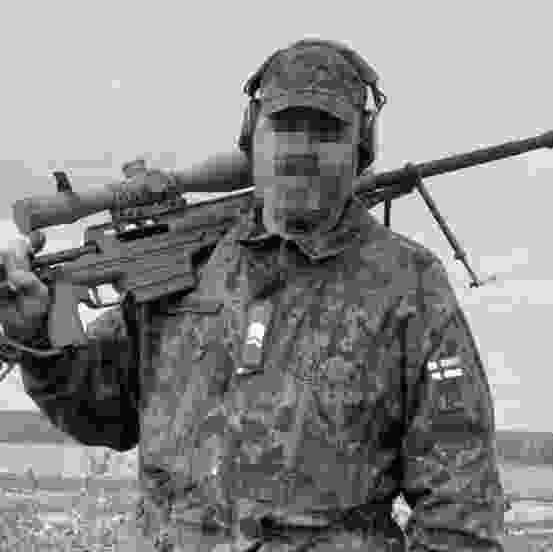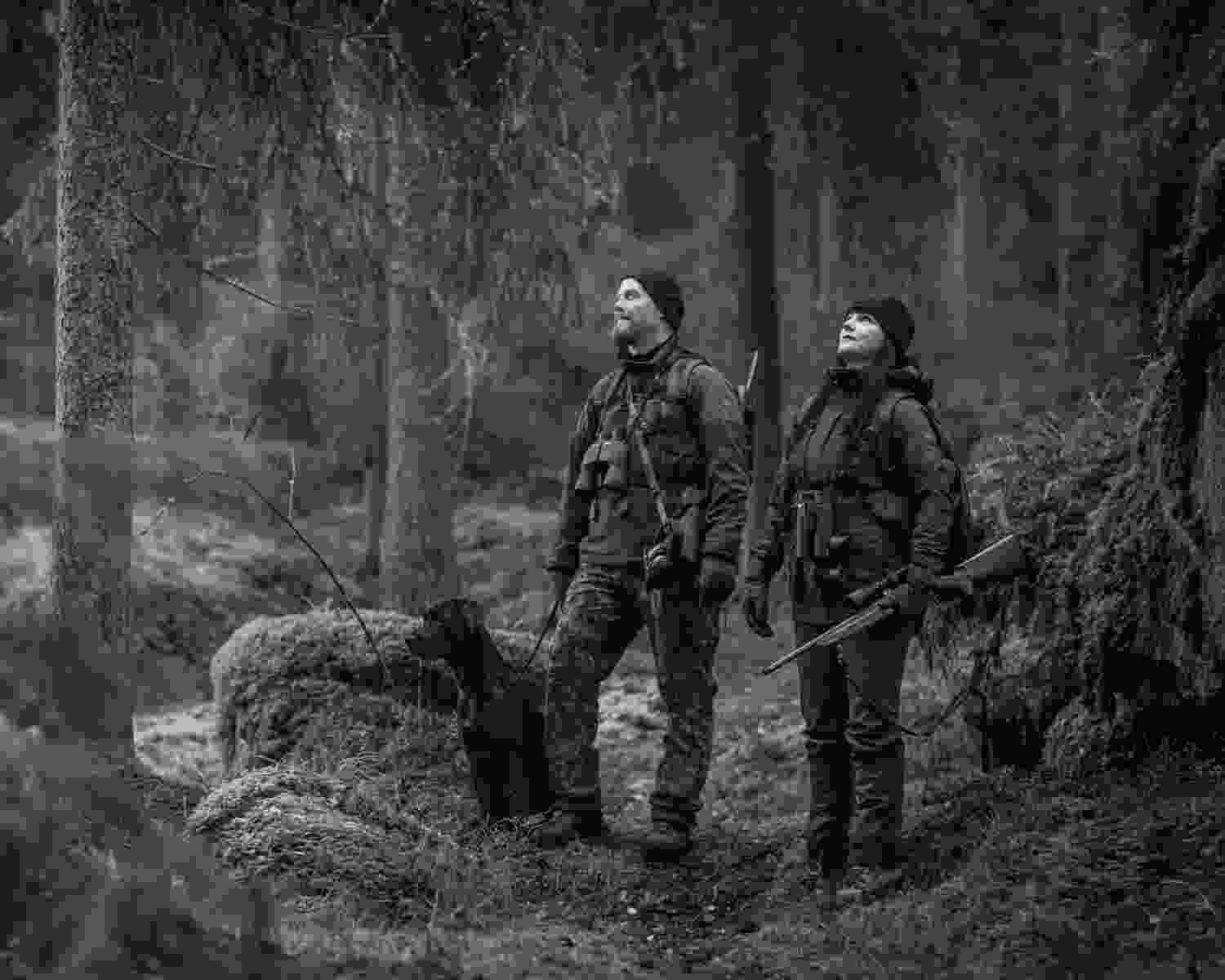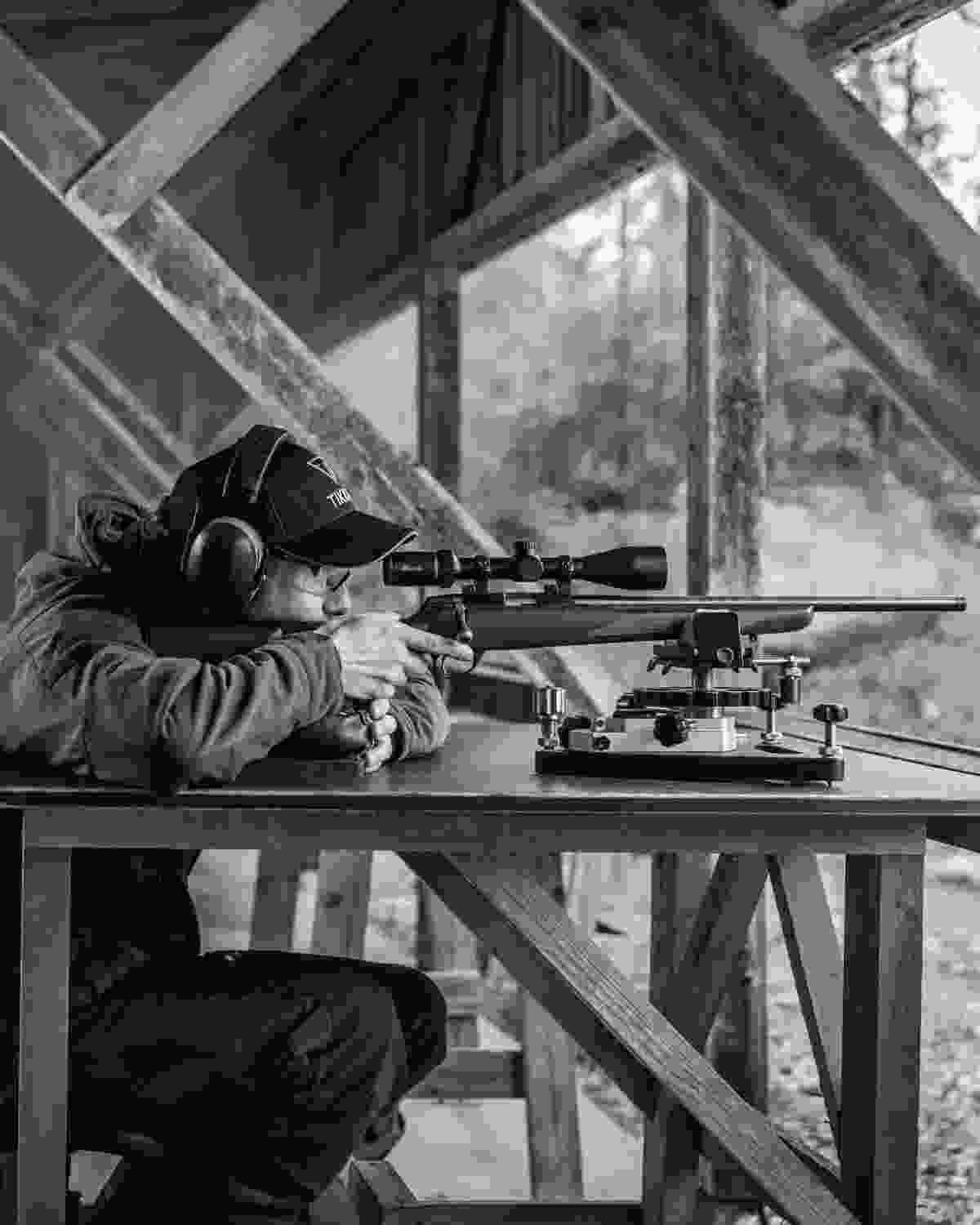

Long range 22lr trainer
Scaling down a small caliber rifle to mimic a larger one is not a new concept, but the challenge lies in optimization. The process of comparing flight paths and adjusting sights is tedious, but the basic principle is simple - similar flight path shapes can be scaled up or down. Though perfect equivalence is impossible, the technique is a useful training tool.
22LR rifles have always been popular. For many of us, the rimfire rifle is the one we have all fired our first shots with. Because of its affordability, the 22LR rifle continues to be very popular. At its cheapest, it is still a fun, ‘hundred-euro cottage gun but, in its most expensive versions, a top-shelf precision tool used up to the Olympic level. Due to the low cost and almost free ammunition, the 22LR rifle is considered as a recreational rifle. But with modern optics and ballistic calculations, shooting distances can easily be increased from the usual 25–50m. You don't have to spend tons of money on a meaningful 22LR long-range hobby. Even in its inexpensive form, the caliber can offer the average shooter much more than most people realize. Those who do, have spent a lot of money building a training rifle that looks and feels as much like a big rifle as possible but fires an inexpensive cartridge. Nowadays, it is common to see even the most expensive rifle scopes sitting on a rimfire rifle – scopes used with the most expensive precision rifles.
In many ways, the 22LR rifle is the ideal practice tool. The required shooting distances are relatively short, and the shooting area does not require map exercises checking large danger spaces or temporary road closures. With rimfire rifles, wind reading, windage corrections, range-finding, and all other ballistic calculations must be done right with equal process. The only practical difference with centerfire rifles is a shorter range. Reasonable 22LR accuracy, even with longer distance shots, does not usually require using the most expensive precision ammunition. Despite its small cartridge, the 22LR is a useful tool for professional use: a suppressed shot bullet flying at subsonic speed cannot be heard, but it can still penetrate up to 30cm of ballistic gelatin – and has been used successfully in urban military context. During the difficult time, in Finnish history, with food shortage - poachers used it up to moose-size game. The idea was to hit big muscle and then chase the animal by ski until it bleeds to submission.
But how to get the most out of your own rimfire rifle?
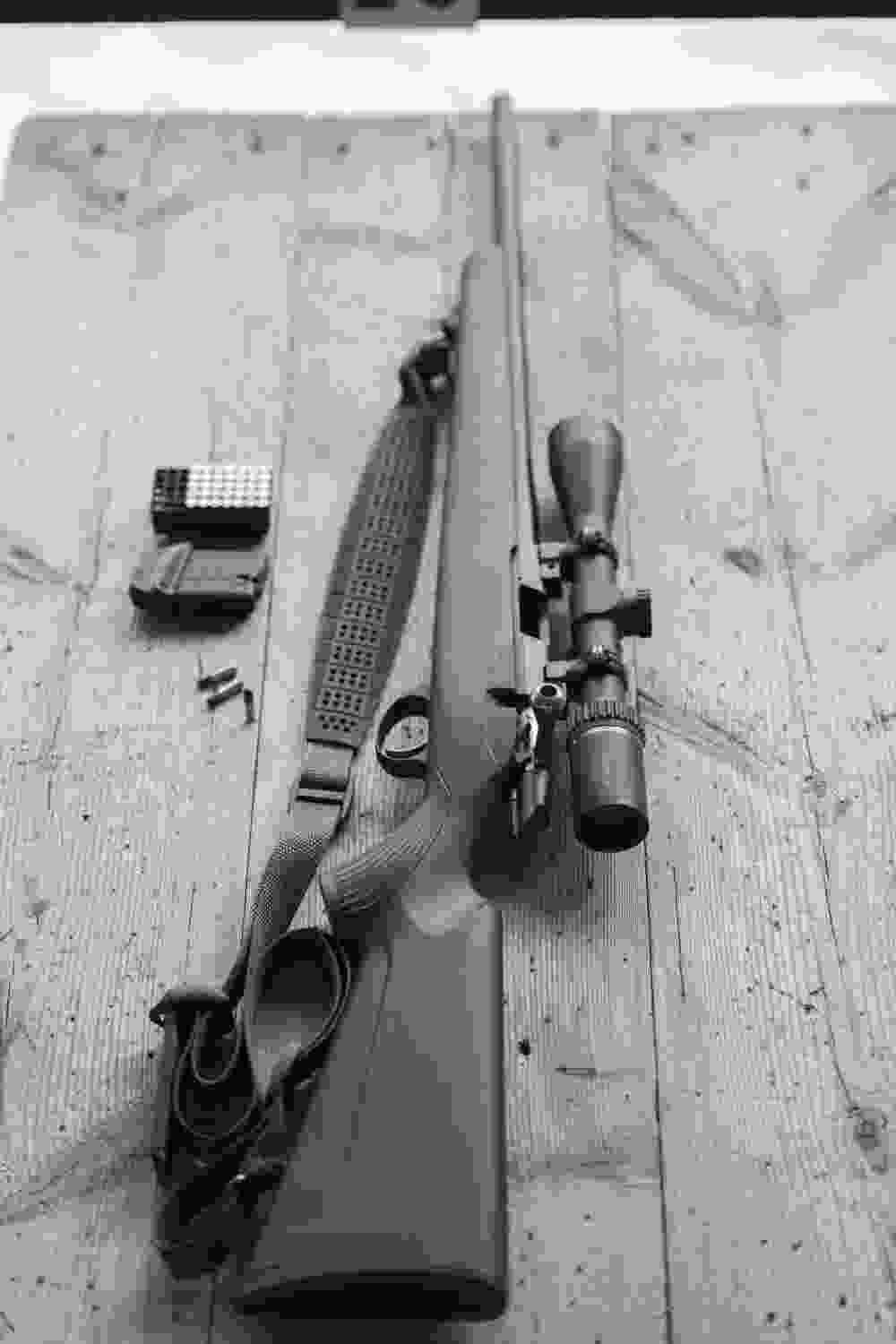
Many of the golden rules of thumb learned with centerfire rifles also apply to rimfire rifles: the bedding of the gun affects the accuracy. Sight must be mounted the right way. A consistent, dimensionally accurate and well-finished barrel is always more likely to deliver good accuracy. The optics are the same as the centerfire rifles: a well designed FFP reticle helps significantly in practical shooting to the extreme distances of the caliber. Sight mechanisms must work accurately and shift reticle correctly. The milliradian, or mrad, 1/10 decimal click value, is the most practical calculations. You do the corrections to the rifle on the fly. Good optical performance helps shooting in many ways: aiming, observing, spotting tiny impact signature, etc. One big difference from centerfire rifles is that accuracy cannot be adjusted only by tuning used cartridge. You directly operate the changes to your rifle. It can be problematic because gunsmiths who really know precision 22LR rifles are rare. When comparing the behavior of a rimfire with different cartridges, it can sometimes seem mysterious. Conclusions about different ammunition groupings may not make sense, or may be unfamiliar. Creating a repeatable good group sometimes seems to require black magic. I say this from personal experience. However, this article does not focus on the “hardware side” or on the generic ballistic trajectory calculations. Both are done the same way and with the same apps with centerfire rifles. This article idea, is to focus on the lesser-known quirks of the ballistic side and the alternative use of the rimfire rifle in long-range practice.
Finding the best cartridge is very laborious at worst. The tools and means are still the same as for centerfire rifles: beside pure accuracy and grouping, you need to find out the exact muzzle velocities, minimize velocity deviation and verify the exact drops at checked true distances.
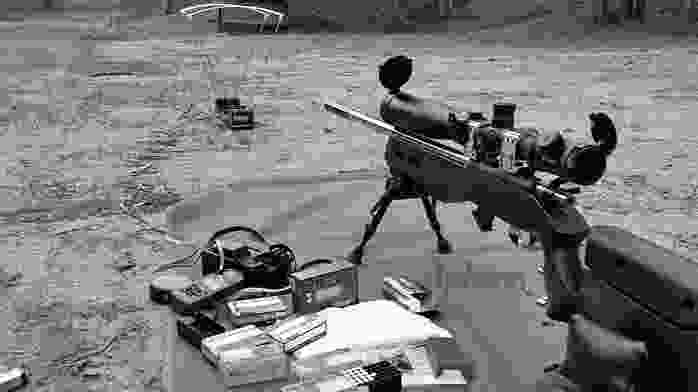

Ballistics and oddities of the transonic area
The 22LR bullet pushes its way through the same air as the larger bullets - with one big difference: the muzzle velocity of a rimfire rifle bullet is low and almost always close to the speed of sound, Mach 1 (M1). Mach is used as the unit of velocity in this article for its direct comparability. Unit includes compensation for the environmental changes: air pressure, temperature and humidity. This clarifies the issue because the speed of sound in a medium, air in this case, varies and depends on aforesaid variables. Ballistic apps will compensate these automatically it if the input data is selected and fed correctly.
Around M1, quirks start to appear exactly at the point where the speed increases from the subsonic range (app. below M0.8, 895fps, 275m/s) through the transonic range to pure supersonic flight: While doing it, bullet passes through a very steeply increasing drag zone. Since the drag changes dramatically with only a small increase in flight velocity, the practical wind sensitivity of a bullet can increase significantly with even a small increase in (muzzle) velocity. By examining the drag curve of the RA4 standard that is optimized for a typical rimfire rifle bullet (figure 1), it can be noted that drag increases more than 200% with only 27% velocity increase, speed change from about M0.9 to M1.15.
The examples in the article also include abbreviations other than the familiar and common "G1" and "G7" drag coefficient standards used in all ballistic software. The abbreviation "Cd" stands for "Coefficient of drag" and describes the actual drag of a bullet. Usually, it is also measured for different speeds, as it is not constant. Cd is not, unlike G1, G7 or RA4, a single numerical value representing the entire bullet trajectory relatively to a certain reference bullet. The term "6DOF" refers to the calculation method used by the most advanced ballistic engines, where the trajectory of a bullet is modelled by the Cd values of the individual bullet by using the six degrees of freedom calculation principle. 6DOF modelling takes into account not only the three directional vectors of the bullet, but also its rotation and horizontal / vertical inclination. Modelling method can also calculate the effects of the bullet's gyroscopic forces on its attitude and thus its effect to trajectory, even the oscillating sway of the bullet caused by gyroscopic stabilization. It's a calculation requiring heavy processing and was used only by advanced artillery calculators only 10 or so years back - it was not possible even with the best smartphones not too long ago. For instance, only 6-7 years ago, my personal Samsung Ultra flagship phone with (then) fastest Snapdragon processor on the market, calculated 338 bullet trajectory to 3000m about 40 seconds. Related to calculations and 22LR bullet drag standards, online sources state that the 22LR specific RA4 drag coefficient function is identical to the G1 function at flight speeds below M1.23 (1395fps, 425m/s). This is not the case. For example, the RA4 drag curve in Quick Target Unlimited program's bullet library is very much different compared to the G1 drag curve in the original McCoy book. Therefore, by using common single-value and single velocity G1 function with a rimfire rifle at long distances, correction values will most likely not correspond reality well.
Tikka T1x MTR
With the Tikka T1x, you can enjoy a variety of shooting activities. The rimfire rifle has a unique cross-over barrel profile, which guarantees the advantages and balance brought by a heavy barrel without significantly increasing the overall weight of the rifle. T1x rifle combines superior quality and craftsmanship, enabling perfect performance on the shooting range and hunting applications.
READ MORE
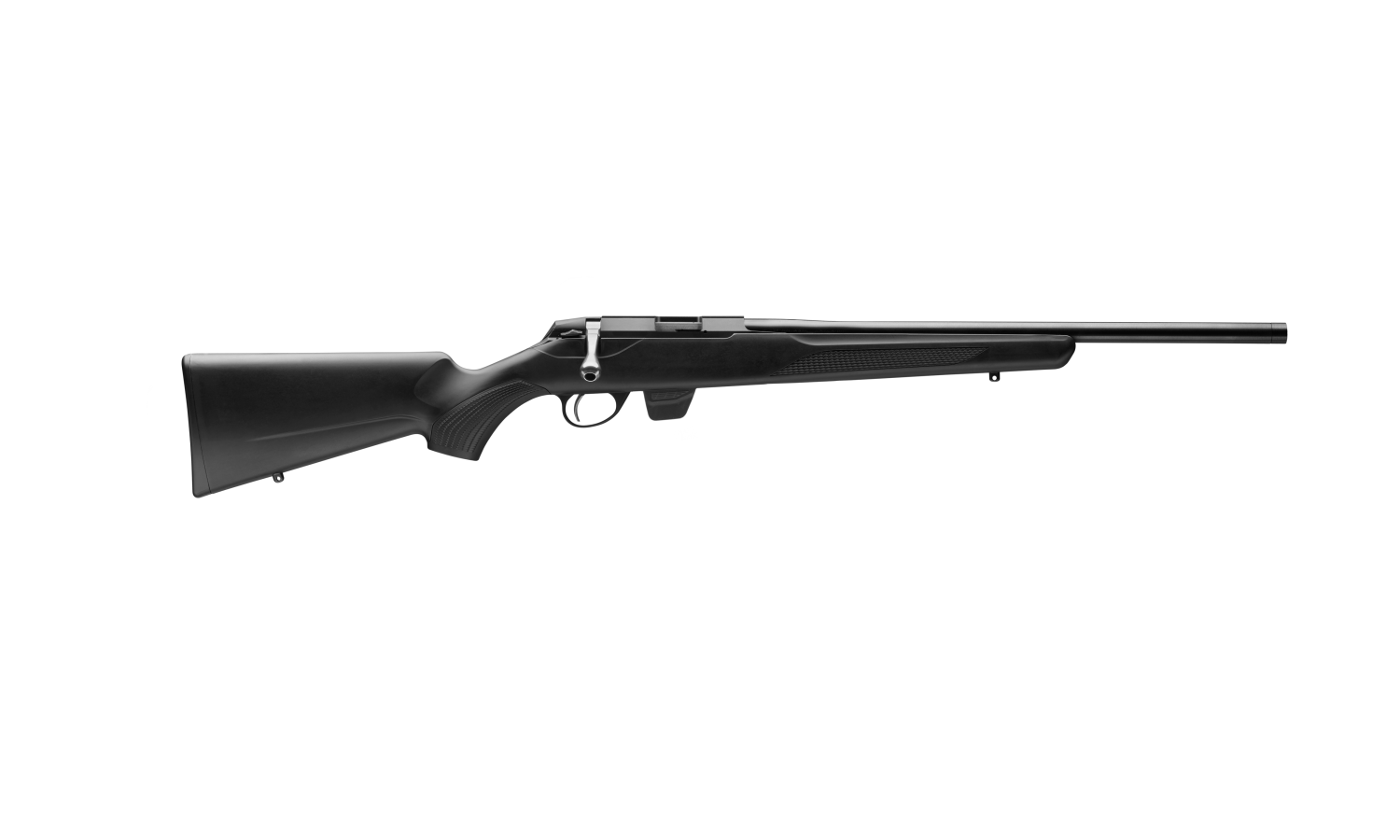
Velocity zone below the supersonic M1 speed but still above subsonic velocity is called intermediate, or transonic, velocity: in the intermediate velocity area there are both supersonic and subsonic flows around the bullet. This has always been challenging part to any bullet long range flight- even today there are known and (otherwise) well performing bullets that are not stable enough during subsonic transition – in practice far at point where velocity drops from supersonic to subsonic via transonic area. The very same aerodynamic principle of sharply increasing / decreasing drag in the transonic region applies to many other flying objects too. It was also a sole reason for the difficulties aircrafts had breaking the sound barrier; much more thrust was needed to get through boundary to purely supersonic airspeeds. Transonic phenomena caused also stability problems, which can also concern bullets travelling in the same velocity range similar way. In the case of the first supersonic aircraft, the Bell X-1, the challenges were the buffeting at M0.88 and finally, at M0.93...M1, strong and surprising “nose down” pitch- while completely losing horizontal stabilizer control. It was not understood at the time but, similar way with bullets, the ‘normal shockwave’ line, above wing separating subsonic and supersonic flow formed exactly at the Mach number of 0.88. This was characteristicto the aircraft and used laminar flow wing profile. As the speed increased towards the purely supersonic M1 velocity, the shockwave boundary moved backwards on the wing surface. At exactly M0.93, the elevator control surface of the X-1 was blocked by the shock wave and its turbulent boundary layer, causing it to lose all its controllability. The solution was a design copied from the British Miles M.52 supersonic research aircraft where, instead of moving the control surfaces only, the entire elevator was moved. The critical Mach speed and the supersonic area on the wing surface, typically in the M0.7–M0.8 region with conventional aircraft wings, caused accidents with other aircraft types too: the P-38 Lightning, capable to transonic speed in a dive, was particularly prone to this. In addition to the corresponding loss of elevator control, the same shift in the wing center of lift/pressure (Cp) with shifting shockwave boundary caused the nose to drop unexpectedly and uncontrollably. Lift center shifted to aft while aircraft center of mass (Cm) remained same, causing again strong nose dip.
The phenomena may sound complex, but the general principles are rather simple and can also apply to bullets. The corresponding shift of the point of aerodynamic forces (Cp) relatively to the longitudinal axis of the bullet is only one effecting factor, but still substantial as it is major force affecting the dynamic balance of the bullet. Bullet center of mass (Cm) does not shift with changing velocity and Cp point, just like it doesn’t change with airplanes- generally. Exceptions exist, like retired Concorde supersonic passenger plane where center mass point was constantly adjusted during flight by pumping fuel between internal fuel cells.
Take-away with this and relation to bullets is understanding that supersonic-transonic-subsonic transition disturbance to the bullet is not about drag only – and it can cause unpredictability in long-range rifle shooting: center of aerodynamic forces acting with bullet and via its mass center change with changing flight speed. If bullet is not gyroscopically and dynamically stable enough, it may cause accuracy problems. Even complete loss of stability while slowing down from supersonic to subsonic flight in the distance. The increased, occasional bullet sway may cause unknown drag variation, thus deviation in point of impact on the target. In the worst case, a straight flight path can turn into a repeating spiral with some meters of diameter- have witnessed it myself with marginally stable tracers. Or, in the worst case, the bullet can tumble to base-first attitude. The various consequences of the same phenomenon have been known with full-size rifles for decades: Even a precise bullet may lose its predictability and accuracy if shooting distance is long enough. With rimfire rifles and subsonic flight speeds, such problems do not usually arise.

Tikka T1x UPR
The core of UPR is fiberglass stock which makes it comfortable to carry on longer trips or on challenging terrains. Carbon fiber bedding surfaces increase the stiffness of the stock, which naturally improves the rifle's accuracy. In addition, the design of the stock takes into account the ergonomic shooting position, even at long distances.
READ MORE

With 22LR rimfire rifles, typical muzzle velocities M0.9–M1.15 correspond to example velocities of 310 m/s and 390m/s, or 1017fps and 1280fps as imperial units. This 25% increase in velocity can increase the flight response by a factor of several folds. With more practical smaller 22LR velocity differences – depending on the cartridge and barrel lengths – initial drag can still vary by tens of percents. Even a small difference in crosswind magnitude and/or the muzzle velocity of a individual shot can therefore cause an unusually large horizontal shift on the target, affecting the longest shooting distances the most. The change in drag also affects the drop and hence the adjustment of the scope's elevation turret, but the effect on vertical direction is not nearly as big as with windage. As the muzzle velocity drops below M1 and towards a pure subsonic airspeed of about M0.8, the horizontal wind drift decreases, turning to increase again at the point where the change in drag levels off and the dominant factor affecting horizontal impact shift is the increase in flight time. In another words, the time bullet is exposed to the (cross)wind before reaching the target. As an extreme example of the effect of increasing drag, a situation where the exactly same bullet is fired at two different muzzle velocities: M0.6 and M1.35 (approx. 205m/s and 465m/s, 674fps and 1526fps). In both cases, the horizontal impact shift at 250m distance in same crosswind is exactly the same. This seems rather odd, as the gain in muzzle velocity is more than double, but the wind drift is not directly proportional to the flight time.
So the ballistics are the same but can also be different, in a very special way. If the muzzle velocity, thus initial phase of flight, is just on the supersonic side or in the high transonic region, the sharply increasing drag can play some unusual tricks. However, a shooter with full-size rifles does not have to lose any sleep over it. The transition from supersonic to subsonic happens far away and is very short relatively to the total flight time. All calibers are also most sensitive during initial phase of flight near muzzle. Beginning of trajectory has always greater impact on the overall shift than the mid-or end of trajectory, because a bullet that has from the initial straight trajectory will continue its flight to same direction. This is also reason why first third of any flight path has 50% effect of total wind drift- despite the fact that bullet bleeds its speed significantly during its flight. The transonic shift can still cause problems with ‘real’ rifles, but, more due to the issues described above. With rimfire rifles, the essential thing is that, in the M0.9...M1.1 muzzle velocity range, even a small change can have a surprisingly large effect: Abnormally large groups in horizontal direction - also slightly vertically -are necessarily not due to gun, shooter or the cartridge. This is important because any precision shooting practice is meaningful only in a situation where the pre-calculated trajectory tables correspond well to the actual flight of the bullet. Only then can ‘bullet feedback’ of a successful wind reading and good shooting performance be correct.
FIGURE 1 / Charts: Bullet drag vs flight velocity and the effect of muzzle velocity on wind deviation at a distance of 250m with two example bullets (brown, green lines). Other lines (dashed red, grey, blue) are bullet drag (Cd) at different velocities (M). Cd values are multiplied with factor of 200x on the vertical axis in order to present chart together with the wind correction at 250m firing distance. The red solid line is drag curve of an RA4 standard bullet, converted to ‘Cd vs velocity’.
The optimal wind drift muzzle velocity with 250m target can be checked by aligning the X-axis (muzzle) velocity point to the lowest point of the wind drift line (brown, green).
If the ballistic calculation is done with Cd values and a 6DOF ballistic engine, lowest point of the line (green) aligns with the M1.0 muzzle velocity. If the RA4 function is used with ballistic coefficient value of 0.125 (brown), optimal muzzle velocity would be M0.92. In these two cases, calculated horizontal drift difference between same bullet at 250m would be 100mm /10cm/4” (same 10mph, 5m/s sidewind). 250m drop is still almost same.
In both cases, the optimal muzzle velocity is at the first third of steeply upward raising drag curve. Cd values above M1 speed (blue) are not known, but it can be assumed that the missing part of the line is very close to same angle, shape and peak compared to RA4 Cd line (red). However, unlike RA4 drag curve, Cd values are measured down to the lowest velocities. Therefore, practical calculations for long range rimfire shots should be much better aligned with real shooting.
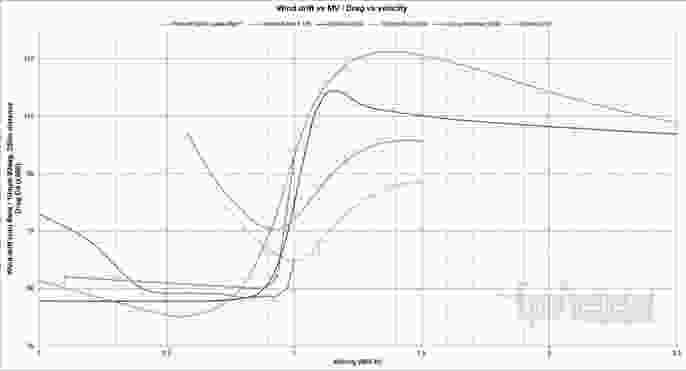
Bullet drop graph (cm) at 250m with different muzzle velocities (X-axis), modelled with two different calculation principle: 6DOF (dashed line) and RA4 function (solid line). Used RA4 coefficient value was 0.122. 250m drops are identical with M0.93 (approx. 320 m/s / 1050 fps) muzzle velocities. Each horizontal line in graph equals 10cm / 100mm / 3.94” impact shift at target.
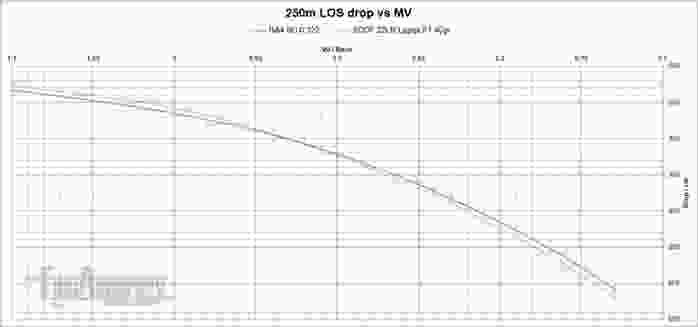
Geometry of the bullets compared to the simulated RA4 standard bullet shape. Not all 22LR bullets are as close to same. IN PRINCIPLE, the same bullet shape (and weight) means good calculation accuracy when using the RA4 function. However, it should be remembered that RA4 drag curve is flat under M0.7 velocity- not matching to real life drag change. Visible bullet base damage from removing it from case, due to violence in another words.
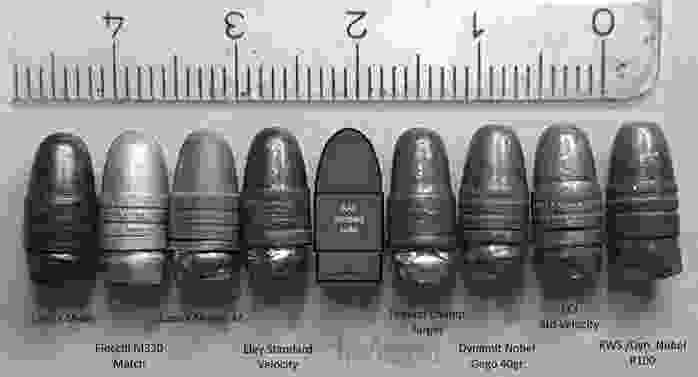

Scaled long-distance practice with a rimfire rifle
The original idea of scaling a rimfire rifle to simulate big rifle came from P. Salo, who used the simple multiplier principle of scaling as a training method with 22LR rifles. Basic idea is old, probably figured out somewhere decades ago already, but is still so interesting that we decided to explore how far we could take it.
The biggest problem with precise scaling is optimization. If done carefully and with wind included, the job can easily require several evenings of error-prone manual tweaking, cross-referencing of individual trajectories by hand. Smooth, precise fine-tuning for windage and elevation truing same time side-by-side is not possible. Also, amounts of scaled bullet drops and wind deviations for multiple distances cannot be perceived without graphical interface. However, the principle that makes scaling possible is still simple because the basic trajectory shapes between different calibers are close to the same. Even a pea-shooter bean flies in similar trajectory with a 155mm howitzer shell, just on a very different scale. Therefore, scaling is possible by changing artificially one of the two - by enlarging or shrinking. Identical match for both drops and winds same time cannot be done in practice- but close or very close match can usually be done, easily good enough for useful scaled practice with 22LR rifle. Example: If the drop of a typical 40 gr 22LR bullet is compared to a typical 308W bullet drop, scale is about 25%. This leads into a situation where same turret click amount of corrected drop between 22LR bullet and bigger rifle is also 25% distance of larger rifle actual shooting distance. For instance - if the target distances for the rifles are 25m and 100 m – correction in mrads is still same in both cases with 25% scaling factor match.
It is useful to scale drops and wind corrections. However, to get the same ‘feel’ with bigger rifle, the size of the targets can and should be scaled in exactly the same way and with same scaling factor. If the targets are downsized too to match the ballistic scaling, the end result from 22LR shooter perspective is same look, feel and bullet behavior. If the 22LR drop and windage scaling match well AND the target size is scaled down exactly right, 22LR shooting turns into excellent simulation of larger rifle. When small targets viewed through a riflescope with any milliradian reticle, the scaled targets appear as they would be in distant large rifle targets and also measure exactly the same when milled – angular sizes are same. In the best case and with good scaling match, scaled 22LR targets can even be shot at with exactly the same elevation and windage turret settings used with big rifle.
Having same milliradian drop in the scaled distance with the same milliradian wind drift in same true sidewind, its training usefulness become obvious- basically 22LR rifle is shot and adjusted exactly like the big rifle. Even the wind measurement is done very much similar way: with both rifles, the same true / measured crosswind will shift the bullet at scaled distance the same amount in milliradians – meaning same sight clicks amount too. Ideally, the larger caliber trajectory cards can match close enough to use the dope charts of big rifle for scaled distances too- while milling targets as they would be non-shirked normal size ones: properly downscaled target will still give “false but correct” further distance, based again on very same scaling ratio. If ranging / milling and wind reading with corrections are done correctly, it will hit or miss just as in actual long range with big rifle.
Scaling tool view, calculated with true ballistic values: Sierra 175gr Matchking, MV 790mps (2592 fps) -vs- Eley Match EPS 40gr MV 325mps (1066 fps). In this case 25% scaling ratio percentage is selected – scaling 500m big rifle distance down to 125m for 22LR. This is valid if rifles are zeroed at 100m and 25m distances. As in highlighted Excel rows, both bullets need close to the same 3.9mrad (500m) vs 3.7mrad (125m) elevation. With selected scaling factor, wind drift is exactly same 1.5mrad at 5m/s (approx. 10MPH) crosswind.
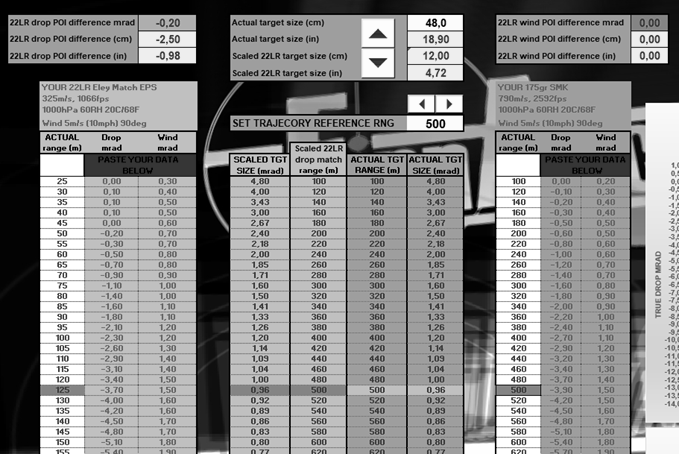
Target size scaling: 48cm/18.9" big rifle normal target size is automatically scaled down to 12 cm/4.72" for a 22LR rifle with set correction factor. If target is scaled precisely to these dimensions, angular size of both targets, 0.96 mrad, is same at both 500m and scaled 125m distances. Milliradian target sizes for all distances are calculated automatically "SCALED TGT SIZE (mrad)" column in screen capture lower center area, as it is useful info when training reticle milling. The full-size target dimension can be resized using the tool's hotkeys, simulated scaled size is automatically calculated in both metric and imperial units.
“SET TRAJECTORY REFERENCE RNG” moves the reference point, in both highlighted rows and line chart view. Upper corners show the exact “POI DIFFERENCE” as mrads and cm / in, also represents same visually in automatically updated line graph. Screenshot is comparing 500m actual and 125m scaled distance. With 25.0% scaling factor, windage scaling error is 0.00 = perfect match (upper right corner). Drop scaling error (upper left corner) at same 125m/500m distances is 0.2 mrad -> two elevation turret clicks -> actual 22LR impact point error at 125m would be 2.5cm/0.98".

The “SET 22LR SCALING RATIO” buttons (on top), steps the scaling percentage up or down for easy data point comparison. Range comparison point can be moved by pressing “SET TRAJECTORY REFERENCE” buttons. 22LR scaling can be changed for drop and wind same time pressing "SET 22LR SCALING RATIO” buttons.
In the capture, green line = Sierra 175 gr, amber line = Eley 40 gr. The upper graph shows same, previously mentioned 0.2 mrad scaling difference in the elevation at simulated 500m/125m distance. However, the horizontal correction at 5mps/10mph wind is identical within a tenth of a milliradian – less than one scope click. This is the lower chart point where wind lines (green, amber) overlap. Dashed lines are, pre-copied references at the bottom of the workbook- not visible in captures. Can be modified as needed. The top one, dashed light blue, is typical 338 Lapua Magnum loaded with a 250gr OTM bullet. Example 25.00% scaling ratio would not be even close to optimal for it.
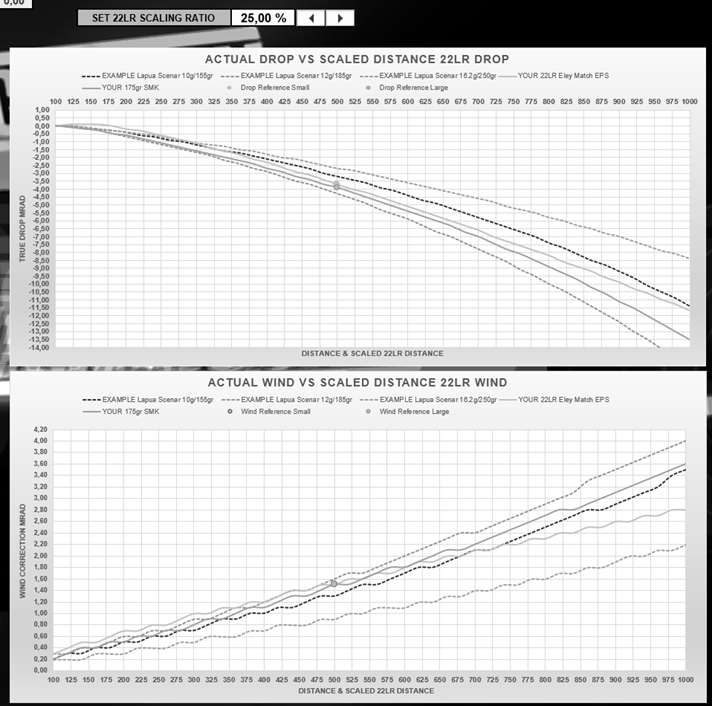
The interface has been made as easy as possible. Any data can be copied into the spreadsheet. One handy way to use your own data is to use free online calculator ‘JBM Ballistics’, which has also good bullet library. The distance for a rimfire rifle must start at 25m and be in 5m distance increment steps ending to 250m. Larger rifle ranges must start at 100 m and have a 20m steps, up to 1000m. Both therefore having 43 data point rows. JBM generates table with desired step interval -> the calculated table can be transferred to Excel easily with the “copy-paste” or “CTRL + C” and “CTRL + V” shortcut keys. The decimal point differences between continents and countries (comma/dot) must also be taken into account: In case of dot, it may have to be converted into a comma. This is also very easy to do in Excel with the “Find and Replace” batch conversion function.

Workbook uses active content. Permission must be granted separately, as Microsoft Windows does not allow full functionality for active workbooks if “downloaded from external sources”. Permission must be given separately to such files downloaded to your computer. Right-click downloaded “LR22LR_v1.1.xlsm file, click “properties”, check “unblock” and close properties window with "OK". Sample image shows an MS Word “doc” file properties window, but the selection is the same. Activate also full editing of the workbook separately when file is opened first time in Excel.
“LR22LR” scaling tool is free to use and available for download in the “Files” section of the Finnaccuracy Oy online store. A Google search with phrase "LR22LR_v1.1.xlsm" will also find it directly.
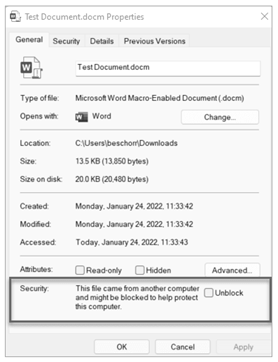
Tikka T1x Hunter
T1x Hunter is a natural addition to the T1x family. The models follows it's bigger sibling features as a classic tool for small game hunting and target shooting. Symmetry design, checkered pattern and a fine finish are guaranteed.
READ MORE
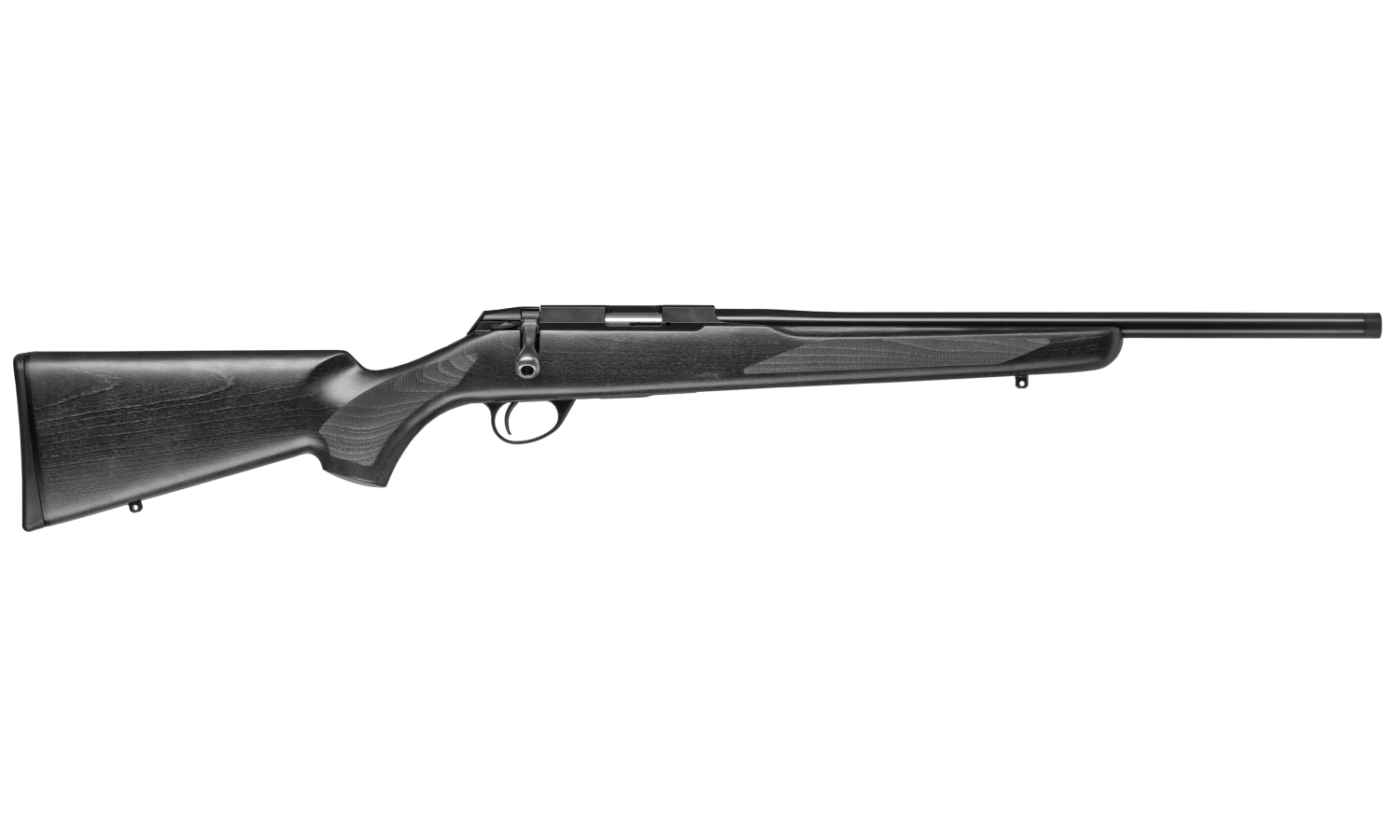
Sounds perfect? It is – almost. The differences come from practical precision, trajectory shapes and other smaller phenomena related to ballistics. A 1MOA group with a big rifle at a range of 500 m would mean that 22LR rifle should be capable of 37.5mm / 1.5” group accuracy at 125m. This is difficult, perhaps more difficult than 1MOA, approx. 150m / 6” group at 500m with large rifle. Also, .22 bullet is big in relation to the scaled target. However, trajectories and required accuracy is calculated on bullet center point hit, not taking on relatively larger diameter into account at all. Situation is equal to shoot target 500m range with a cannon instead of a .30 caliber bullet -edge hits are easier. In terms of 22LR windage, the trajectory shape/curvature is simply not the same with larger rifles. In general, the scaling that best matches the elevation will keep the wind correction the same or close to the same for (scaled) average distances up to about 200m, but, after that the 22LR will deviates less in the wind than big brother. However, such distances are rather long for a 22LR gun when using small targets- as it would be very long 800m range for 308 Win too. Difference / error is still relatively small compared to the total wind drift. Another issue comes with drop: typical end of 22LR trajectory, or ‘chart line tail’ in scaling tool is too straight. Also, for the shortest distances, the 22LR will never match perfectly- and any visibility interference, like mirage, much more forgiving in short scaled ranges. This will not affect bullet flight, but it may matter with milling exercises. Gyroscopic spin drift is something that cannot be scaled 1:1 directly, nor can other small details such as the aerodynamic jump of a bullet.
All in all, there is always a certain difference in the trajectory shapes, error that cannot be corrected by using only one universal scaling value. But, scaling can be still close in practical shooting and be still very useful. Scaling tool allows you to experiment it and fiddle with various target sizes, without wasting even one shot or target patch. The tool shows milliradians, centimeters and inches directly without any further manual calculations or head-scratching. Exact data points can be easily moved to different distances by simply pressing the ‘set trajectory reference range’ buttons. Give it a try and see it by yourself!
Author: Jarno Lankila
For some, sport shooting is a hobby, for others a profession, and then there’s group of people for whom sport shooting is much more than that. Jarno is a sniper / sniper instructor, but his detailed bio will remain confidential. We have the privilege to have him as one of our guest authors
